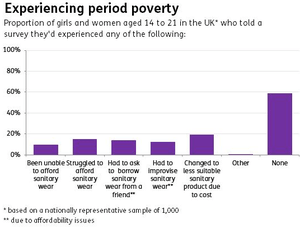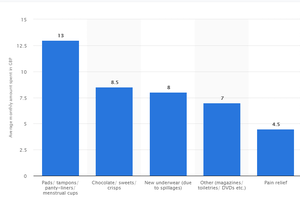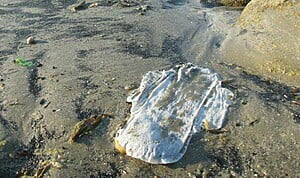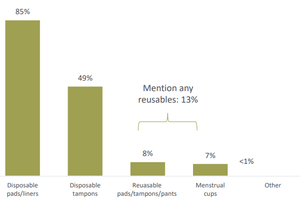Menstruation is as old as the human race and is a core part of our biology. Yet, despite being a core bodily function, periods have been shrouded in taboo for thousands of years, and society still shuns menstruating women.
In the last 100 years or so, we have learnt collectively to engage with the subject of menstruation.
Huge progress has been made, but there is still so much work to be done.
Periods are still heavily marginalised even in Western or more developed countries, and in poorer countries, period taboo is still widespread.
Evidence also suggests that fair access to sanitary products is still generally poor.
For example, in the UK today, a survey conducted by the charity Plan International found that, remarkably, 1 in 10 girls are still unable to afford sanitary products. Worldwide, over half a billion girls live month to month in period poverty.

One method we have to combat period poverty is to end the commercialisation of menstruation.
By lowering the costs of sanitary products and turning towards reusable, sustainable and recyclable alternatives, we can collectively improve menstruation for girls and women worldwide.
Reusable pads are an invaluable tool in our collective journey towards period equity. They help access to sanitary products and help battle period poverty, taboo and superstition.
Table of Contents
What Are Reusable Pads?
Many women have still not heard of reusable period pads. Fortunately, this is changing.
Put simply, reusable period pads work in broadly the same way as disposable period pads, apart from the fact that they are not thrown away after use.
Instead, reusable pads can be removed, washed and reused. The process is quick, easy, clean and comfortable, and there are many benefits.
More and more women are turning to reusable pads for a variety of reasons that we will describe below!
Reusable Pads Are Cheaper
As we all probably know, menstrual and sanitary products are not cheap. Unfortunately, their disposable nature also means women have to keep buying them.
On average, women in the UK spend £13 a month on sanitary products. That works out as almost £10,000 across a woman’s average lifespan!

Given a woman’s average monthly expenditure on disposable sanitary products, reusable pads can save women huge quantities of money.
Though it may not initially seem like an awful lot to some, £13 a month adds up quickly. For many, the cost of disposable sanitary products is a real issue. The Plan International study also found that more than 1 in 10 girls (12%) had improvised sanitary products as they couldn’t afford them, and that 1 in 7 (17%) had asked friends for sanitary products as they couldn’t afford them themselves.
Why Reusable Pads Help: They Save Money and Increase Access
Reusable pads are a simple way to combat the ongoing month-to-month costs of menstruation. Whilst the initial costs may be slightly higher, there is no doubt that costs in the long-term are massively reduced.
This is massive for women who struggle to afford standard main-brand sanitary products. But even if you can afford sanitary products, the cost savings for any woman are impossible to ignore.
Reusable Pads Are Better For The Environment
The health, cosmetics and personal care industry’s terrible environmental impacts have received massive coverage in recent years. Sanitary products play a big role.
A stunning 200,000 tons of sanitary products end up in landfill in the UK alone. Over 1 million sanitary products are flushed down UK toilets every single day. Worldwide, the stats are even more shocking, with some 12 billion tampons and sanitary towels ending up in landfill in the US alone.
Once it reaches the landfill, disposable towels and other sanitary products will take hundreds, maybe even thousands of years, to biodegrade. As a result, they don’t just end up in landfills but in our oceans and rivers – they were found to be the 5th most commonly discarded item on UK beaches.

The problem is, not only are typical sanitary products manufactured from poorly biodegradable synthetic fibres, but they also contain traces of plastics (or use plastic inserters in case of tampons). And then there’s the packaging itself…not just the outer packaging but the near-endless sheets of plastic found inside the packaging of most typical sanitary products.
Why Reusable Pads Help: They’re a Sustainable Alternative
As the health and cosmetics industries broadly move towards a greener future, the sanitary product industry has no option other than to follow suit, so long as demand for non-eco-friendly disposable products decreases.
Reusable pads are typically constructed from cotton and other natural materials that can be easily sustainably sourced. Once purchased, reusable pads are recycled by washing them. That means less waste, less environmental destruction and fewer sanitary products ending up in landfill.
Burdening women with the responsibility to change the cosmetics industry is not what anyone wants. Bu building a higher level of awareness around reusable options is critically important.
Reusable Pads Reduce The Commercialisation Of Periods
One of the key questions in the struggle against period poverty is “why should menstruation be a profit industry?”
It is true that menstruation has become a more widely accepted topic, but this has also opened up new business opportunities for profiteering.
In fact, menstrual awareness has been repeatedly identified as an ‘opportunity for business’.
This business report by Fortune Insights says the world sanitary products industry is worth over $50 billion and is forecast to rise!
The Great Ongoing Costs Of Periods
There is no doubt that menstrual and sanitary products are heavily marked up from their ‘cost price’. Scotland is the only country in the world to place a legal obligation on councils to provide free sanitary products where needed, as is the case for condoms and other items deemed essential for health.
The purpose of this isn’t to erode the free choice that women have when selecting sanitary products; it’s to make sure that when needed, sanitary products are absolutely guaranteed for those who need them. As it stands, women largely have no choice but to exchange their hard-earned cash with billionaire industries when dealing with menstruation.
Why Reusable Pads Help: They Reduce Demand for Expensive Products
By using reusable pads, women everywhere are sending a signal to the billion-dollar industries that profit from this normal bodily activity.
If women reduce their demand for sanitary products, these huge commercial industries will have no option other than to slow down their production. Their profits will dwindle, and the narrative that periods are ‘dirty’ will change
Reusable Pads Change The Narrative Around Periods
A significant barrier preventing women from switching to reusable pads is that they feel they’re ‘unclean’ or ‘inferior’ to main brand products.
Scottish market research into reusable pads found that many women had heard of them but were unsure about their cleanliness or hygiene. They were used by a small minority of women and girls.

Some respondents were also worried about feeling ashamed by washing their period products. They could also be worried about them being found by their parents/others in the washing.
Some of these preconceived ideas about reusable pads result from a lack of clear info and coverage. Some relate to the persistent taboo of periods and how women still feel ashamed of them even today.
Why should washing reusable pads be considered different from washing any other piece of clothing? All clothing comes in contact with the body in some form. Period pads that help women deal with menstruation are no different from jumpers that help us deal with the cold. Besides, period blood is no less ‘clean’ than normal blood anyway.
We wash clothes that might be bloody from cuts and scrapes, caked in mud, or covered in other bodily secretions, don’t we?!
Period Blood as ‘Unclean’ is a Myth
It is a longstanding myth that period blood is somehow ‘unclean’, ‘dirty’ or ‘nasty’.
Even the term ‘sanitary product’ alludes to this in some way.
No ‘blood’ as extracted from any part of the body is in any way ‘pure blood’. All blood contains a mixture of red and white blood cells, platelets for coagulation, urea, or waste products, and a pretty colourful array of bacteria and other bits and pieces.
Period blood is the same.
Think of it this way. Period blood comes from a part of the body that is sanitary, clean and hygienic enough to support the development of a baby human.
Why Reusable Pads Help: They Send a Message Across Wider Society
Changing attitudes towards reusable pads is essential in changing attitudes towards periods as a whole. Treating reusable period pads the same as any other piece of clothing we stick in the washing machine is a great way to de-marginalise menstruation.
Whilst we might feel that period liberalisation is already happening in the UK and other more affluent countries, the same is certainly not the case everywhere. By gradually de-marginalising the topic of periods here and elsewhere, the hope is that similar changes will follow everywhere.
Reusable Pads Are Comfortable And Sanitary
Reusable pads are very well-built as they’re built to last for longer than disposable pads. Also, with thicker, more durable materials, they won’t leak. This also means that they’re as sanitary or hygienic as usual disposable pads.
Reusable pads are available for light, medium and heavy flow. In addition, pads for daytime and night-time, as well as panty-liners, are all available in a reusable form.
As well as increased comfort, the organic and natural materials used in sanctuary pads are much better for the body. In addition, organic cotton is hypoallergenic (unlikely to cause allergies).
Reusable pads are free from harmful chemicals that repeatedly pop up in main-brand sanitary products. One such chemical is dioxin, a known human carcinogen that the WHO has warned about. Other plastic and synthetic fibres in disposable pads can also cause irritation, even worsening the effects of cramps and other period-related pain.
The organic and non-synthetic fibres used in reusable pads do not contain harmful chemicals, and many women actually report that their period symptoms were greatly relieved by making the switch to reusable pads.
Why Reusable Pads Help: They’re Good for the Body
Disposable pads and other typical commercial sanitary products contain many synthetic fibres. Some of these can be harmful over long periods. The plasticky fibres of disposable pads can also cause dryness and irritation.
Reusable pads use cotton, one of the most skin-friendly fibres. They don’t contain harmful or irritable chemicals and can improve vaginal health. Cotton and fleece are also much more comfortable against the body.
The Many Benefits Of Reusable Pads
As you can see, reusable pads have many benefits for women and the environment too. They’re a cheap and comfortable way to tackle wider issues that face women and the marginalisation of menstruation.
Reusable pads don’t sacrifice anything in the process. The only reason they’re not more popular is that awareness of reusable pads is still low.
The vice that commercial industries have on menstruation is still strong. Breaking this down can help girls and women living in period poverty.
For every pack of reusable pads you buy, Trade to Aid will donate one pack of reusable pads to the women and girls who need them the most, whether in a refugee camp, conflict zone or natural disaster zone. We distribute our pads directly through an NGO network, and we are a 100% non-profit operation. Any profits we make from selling our reusable pads will be donated to menstrual education projects in West Africa.
That means by switching to reusable pads to Trade to Aid, you can also contribute to alleviating period poverty for those who need it the most.
